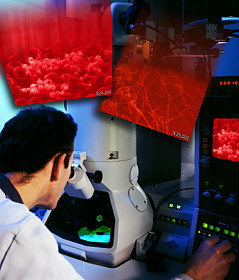 Researchers who presented their work at the October AABB Conference in Boston, MA have shown that donor red blood cell (RBC) metabolites may be related to post-transfusion in vivo RBC survival. Previous research had demonstrated that red blood cell metabolites concentrations change while blood is stored, and that these levels vary across donors. Using metabolic profiling methods, Dr. Larry Dumont and colleagues examined the concentrations of 270 metabolites between four experienced blood donors, two of whom had a history of high post-transfusion recovery (88% and 85% RBC survival 24 hours post-transfusion after 42 days of storage) and two with low recovery (each 74%). The donors gave a whole blood donation that was evaluated at different time points (0, 7, 14, 21, 28, 35, and 42 days). Depending on storage duration, three to nine biochemicals were significantly different between the high-recovery donors and the low-recovery donors. Furthermore, the researchers found that the concentration of cytidine, a nucleoside molecule, was four to five times greater in low-recovery donors than high-recovery donors, and that these differences were also apparent even at the time of donation. This work begins to identify the metabolites important to RBC survival and could lead to development of pre-donor screening to improve transfusion outcomes.
Researchers who presented their work at the October AABB Conference in Boston, MA have shown that donor red blood cell (RBC) metabolites may be related to post-transfusion in vivo RBC survival. Previous research had demonstrated that red blood cell metabolites concentrations change while blood is stored, and that these levels vary across donors. Using metabolic profiling methods, Dr. Larry Dumont and colleagues examined the concentrations of 270 metabolites between four experienced blood donors, two of whom had a history of high post-transfusion recovery (88% and 85% RBC survival 24 hours post-transfusion after 42 days of storage) and two with low recovery (each 74%). The donors gave a whole blood donation that was evaluated at different time points (0, 7, 14, 21, 28, 35, and 42 days). Depending on storage duration, three to nine biochemicals were significantly different between the high-recovery donors and the low-recovery donors. Furthermore, the researchers found that the concentration of cytidine, a nucleoside molecule, was four to five times greater in low-recovery donors than high-recovery donors, and that these differences were also apparent even at the time of donation. This work begins to identify the metabolites important to RBC survival and could lead to development of pre-donor screening to improve transfusion outcomes.
Reference
1. Dumont LJ, Zimring JC and Roback JD. Correlation of RBC Metabolomic Changes During Storage with RBC Survival After Transfusion in Human Autologous Donor/Recipients. AABB Conference 2012. Boston, MA, 2012. Transfusion 2012;52 Suppl 3: 11A-284A.
